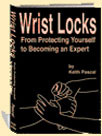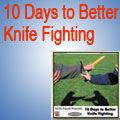
|
Making Your Wrist Locks Work:
by Keith Pascal
Do you think that wrist locks don't work either on you or for you? Do
you feel that you'd demolish anyone who'd dare try to snap a joint lock
on you?
If you answered yes to all of the above questions, then I'm willing to bet
that you aren't as good as you think. Sorry to have to burst your bubble.
If you are still with me (you didn't just pass over this article in disgust),
don't worry! Take heart, or at least suspend your skepticism, until you've
read this article.
I have a quick fix. This quick fix works for martial artists who have trouble
using a joint lock as an effective move.
Note: Coincidentally, I offer the same remedy for the opposite
person. This training application works for the mid-novice martial
artist who constantly tries to force a lock, even when to do so
would be extremely dangerous.
This is actually a good thing; in a short time you'll be able to pop a wrist
lock on all of the other Doubting Thomases (and Doubting Thomasinas, too).
So how does this misconception form? This myth develops when one's
view in the martial arts is too narrow, and also when it's too broad.
The too narrow view develops when some martial arts students of
styles or systems that heavily emphasize locks have become disenchanted
with their style. The students have been faithful to a single style -- they have
studied the pure form, yet their wrist locks aren't effective in a real
confrontation -- they keep getting hit.
Not the most desirable outcome in an altercation. Why does this happen?
This phenomenon can occur when their style is too limited, and the style
itself isn't founded on realism. One of the reasons Bruce Lee developed his
own system, was because of the limitations and lack of preparation for
real encounters that he found in certain single styles.
Disenchantment can also occur, when students quit a good style too soon.
If they had the patience, they eventually would have found a system that
trains for real situations. This becomes almost a "chicken and egg paradox."
Did they give up too soon because they were disappointed, or did they get
disappointed because they gave up too soon?
They don't stick with the style long enough to learn how to make their
wrist locks effective. They never get a chance to learn from their instructor
when to and when not to use joint locks. They never learn the proper
preparation for a successful lock. Pity.
The broader perspective people tend to practice progressive martial
arts that combines styles into broader systems. Often, they practice some
variation or offshoot of Bruce Lee's Jeet Kune Do (JKD).
These eclectic martial artists also sometimes have difficulties effecting
joint locks. Why? Because their view isn't as broad as they might think.
I use the term "broad" loosely, because I have encountered a slug of
progressive martial artists who have pretty narrow minds.
Recently, I attended a JKD Seminar (plus convention and banquet). A
martial arts instructor asked my wife to introduce us. They had previously
been discussing Wing Chun Dummies (my wife and her father built an
excellent one with myrtle wood arms) .
Within 20 seconds after shaking my hand, he blurted out that
"Wrist locks don't work."
Obviously, he knew me as the author of the book on wrist locks
(more information on this book at the end of this article). And obviously, he
was trying to "get my goat."
He even patronized me by saying that wrist locks might be the only
option for someone not allowed to hit (like a police officer or a security
guard), but that he was a hitter.
At first, I was a little annoyed, but my irritation turned to pity. Here we
were in the middle of a seminar honoring Bruce Lee --- the man who
popularized the notion of "emptying one's cup," so the cup will have room
to hold better and more effective knowledge.
This martial arts instructor's cup was already filled. And he wasn't
the only one.
Note: Actually, there is always something that
the current "pop-teachers" are protesting.
One year, wrist locks don't work--so, they
bad mouth Ju-Jitsu, Chin na, and Aikido. Another
year, trapping was no good, so Wing
styles came under attack.
Not to worry, I have spent and continue to
a lot of time helping people to make
locks work, and my instructor has spent a
lot of time helping folks with their trapping techniques.
From year to year it's the same story with a new
theme. Those who can't make a technique work
are obviously the first to claim that it's the technique
that's at fault. It's a great ego preserver.
Well, he and I had a "friendly discussion," which eventually turned to
other topics. Later, we even talked about magic tricks. Why didn't I snap
a powerful wrist lock on him and prove to him that he was wrong?
I was tempted -- for a split second, but...
I love the code of ethics of our organization. Since both of us were (are)
recommended instructors in the organization, we knew not to bicker.
We conducted ourselves in a mature manner. And we agreed to disagree.
Wouldn't it be great if other organizations could deemphasize their
differences and share their love for martial arts....uh....umm... (sorry for
the gaze through my rosey-colored glasses).
So, for my Texas instructor from the seminar and all of you who haven't
been able to snap your locks on at just the right moment, here is the exercise
(drum roll please):
Sometimes it's the simple advice that's the most useful. Before I explain
the rule in detail, I'm going to make three assumptions:
1. You have some sort of a martial arts base. You know
how and when to hit and kick, and you can do so in
rapid succession.
2. You already know a few locks.
3. And you could do them effectively, if the conditions
were "just right,"--even though they don't seem to
work when you really need them.
Note: If you don't have any martial arts skill
(assumption #1), enroll in a good martial arts class
sooner than later.
And if you don't have any joint locking skill
(assumptions #2 and #3), you could start by
getting my book Wrist Locks: From Protecting
Yourself to Becoming an Expert.
And you should definitely continue reading the
Martial Arts Mastery. It keeps you thinking
about the arts. It strives to present informative articles
that spark your enthusiasm. It definitely shows you an
important aspect of what's out there in the martial arts.
They don't even slow the punch down. They try to grab at it.
This is pure insanity.
By forcing my students to hit three times first, I guarantee
that they won't pull a dumb stunt like trying to grab a speed punch.
Locking later also takes some of the heat off of the lock. My
students don't think about it as much, so they don't get nervous
in preparation for the "move."
Anticipation in martial arts can be a good thing, but it can also
be very bad. Anticipation to the point of preoccupation doesn't
fall into the "good" category.
In other words, don't worry -- let the lock happen naturally.
To do this, you need to know a lot of entry points into some good
locks. You already know where I'd suggest you go to learn more.
I hear my skeptics almost shouting "why not just keep hitting?
Why bother to ever try a joint lock?"
Hitting is good. But it isn't the end-all (pardon the pun). A joint
lock is a control move. You use it to bring the encounter to a more
efficient close. You can stop the fight, or at least pause it, until you
decide to continue wailing on your attacker.
A wrist lock would keep the attacker away from a weapon --remember,
it's the issue of control. You control your opponent, until the police arrive.
And speaking of police, it looks a lot better to the police, and the
witnesses, when you have the situation locked down with a control,
rather than to have them arrive while you're wailing on your assailant.
Hmmm, hit or lock?
Do what you need to do. I would never give you legal advice, since
I'm not a lawyer, and also each particular situation varies greatly.
Personally, I like to hit and kick. It's not always practical to
continue to do so.
See, I wasn't so different from my Mr. Skeptic at the seminar.
I want to pound on them too -- then I want to wrap the encounter
up in a tight, neat little package (tie 'em up with a good lock).
Mr. Skeptic and I both have the same basic dessert; I just want a little
icing on my cake.
Now, go out there and start hitting first. Remember, strike at least
three times.Whether you're hitting or kicking, fire them out in rapid
succession.
Don't wait for your opponent to block. Just pick your targets and
straight blast. And then bring the encounter to a quick close with a healthy
wrist lock.
Let me know how this works for you. Good locking.
Readers who enjoyed the above article also liked the following article: These Articles Are Just the Tip of the Icebergby Keith PascalI hope these articles are of value to you. Did you know, my books and ebooks contain actual detailed instructions? In almost all genres, articles are cursory looks at a subject. They don't go into a lot of detail. You don't discover everything you need to know. You skim the subject. Not so with books and ebooks. I am dedicated to providing books that really teach you how. You really get to sink your teeth into a subject. You gain skills. For example, a lot of martial artists know a wrist lock or two. Very few of them can make their wrist locks work in a variety of situations. You can read articles all day long, but if you really want to master wrist and joint locks ...
This book takes you beyond mere technique.
You will control with wrist locks -- guaranteed!
Martial Arts Mastery: A Tell-All of Tips, Tactics, and Techniques (Free, weekly martial arts ezine -- filled with practical tips. |
Sign up now:
9-Part
Hand-to-Hand
Combat Course
(We'll never trade or sell
your name or email address.)
A confirmation
email has been sent
to your email
address.
Click on the link in
the email, to start receiving your
combat course.

Kerwin Benson Publishing
2749 Friendly St., Suite 200
Eugene, Oregon 97405
USA
 Is it time for you to transform yourself into a wrist and joint-lock expert? Click here.
Is it time for you to transform yourself into a wrist and joint-lock expert? Click here.

